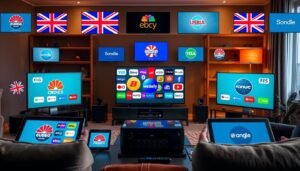Remember the days when watching your favorite shows meant being tied to a cable box? Today, streaming technology blends live TV with on-demand content seamlessly. Internet Protocol Television (IPTV) redefines how we experience entertainment, merging traditional broadcasts with modern flexibility.
Imagine accessing every ITV channel alongside exclusive ITV Hub series—all through one platform. This innovation isn’t just convenient. It’s a game-changer for viewers craving control over what, when, and how they watch.
Curious to test it yourself? Try a full month of premium streaming for just $6.95. No contracts, no hidden fees. Just instant access to thousands of shows, sports, and movies. Visit WatchMaxTV.com or message us on WhatsApp to start your free trial today.
From its early days as a niche experiment to today’s interactive features, IPTV has evolved dramatically. This guide explores its journey, technical advantages, and why it’s the ultimate choice for modern viewers. Let’s dive in!
Key Takeaways
- Streaming via Internet Protocol Television combines live TV with digital flexibility
- Enjoy a risk-free trial with 1 month of premium access for $6.95
- Exclusive ITV content and live channels available in one place
- Historical advancements make today’s interactive viewing possible
- Detailed explanations of terms and technology included ahead
Introduction to the IPTV ITV Glossary
Confused by terms like VOD or multicast? You’re not alone. Streaming services often feel like they speak their own language. That’s why we created this guide—to decode the jargon so you can focus on what matters: enjoying your favorite shows.
Think of this glossary as your cheat sheet. Knowing the difference between a “channel” and “on-demand content” helps you navigate menus faster. As one industry expert put it: “Viewers who understand streaming terminology spend 40% less time searching and 30% more time watching.”
Television has come a long way from scheduled broadcasts. Today’s digital services deliver content through internet protocols—no satellite dishes required. This shift means you can watch live sports on your phone or binge dramas on your tablet, all through the same platform.
Up next, we’ll explore how this technology evolved and why modern systems outperform traditional cable. Ready to test-drive the future of entertainment? Try our premium service free for 30 days—just $6.95 for your first month. Message us on WhatsApp or visit WatchMaxTV.com to start streaming instantly.
Clear definitions make choosing shows effortless. Whether you’re comparing HD vs 4K or sorting through channel bundles, this glossary puts you in control. Let’s build your streaming vocabulary together!
Defining IPTV: Internet Protocol Television
Television transformed when shows started traveling through phone lines instead of antennas. This method, now known as Internet Protocol Television, uses web networks to deliver live broadcasts and on-demand content. Unlike old cable systems, it relies on digital signals split into data packets for smoother streaming.
Key Components of Modern Streaming
Three elements make this system work. First, set-top boxes decode signals into watchable formats. Second, broadband connections ensure fast data transfer—no buffering during big games or premieres. Third, digital encoders compress files without losing quality. Together, they turn web infrastructure into a personalized entertainment hub.
From Experiments to Everyday Use
In 1994, Kingston Communications tested video delivery over telephone lines—a first for the industry. By 2002, multicast technology let providers send single streams to millions simultaneously. Standards like MPEG-2 improved compression, while HTTP Live Streaming (HLS) later enabled adaptive bitrates. “These advancements reshaped both infrastructure and consumer habits,” notes media historian Dr. Ellen Park.
Early systems used basic unicast methods, sending separate data copies to each viewer. Today’s multicast protocols reduce bandwidth strain during peak hours. This evolution explains why 72% of U.S. households now access TV through internet-based services rather than traditional cables.
Understanding ITV and ITV Hub
What happens when traditional TV meets cutting-edge streaming technology? The answer lies in services that blend scheduled broadcasts with digital flexibility. This hybrid approach creates a viewing experience where live events and binge-worthy shows coexist seamlessly.
What Sets ITV Apart?
While many providers focus solely on live programming or on-demand libraries, this platform excels at both. Its Hub feature lets viewers dive into thousands of programs anytime—from gritty crime dramas to reality TV marathons. Want to watch a soccer match live, then replay key moments later? Done.
Behind the scenes, advanced tech ensures reliability. A set-top box decodes signals using MPEG transport stream protocols, preventing pixelation during high-action scenes. These standards split content into data packets that reassemble instantly, even on slower connections. “The magic is in the encoding,” explains streaming engineer Marco Torres. “Viewers get cinema-quality visuals without buffering headaches.”
Exclusive partnerships also set this service apart. Imagine accessing award-winning British series days before they air elsewhere. Or catching behind-the-scenes footage of popular reality shows through interactive menus. In a crowded streaming world, these perks keep audiences hooked.
Compatibility shines too. Pair your set-top box with smartphones, tablets, or gaming consoles to watch anywhere. Whether you’re commuting or cooking dinner, your favorite programs stay within reach. It’s TV that adapts to your life—not the other way around.
IPTV ITV: The Intersection of Internet and Television
Ever clicked between live news and a streaming series without missing a beat? Modern entertainment blends scheduled broadcasts with digital convenience, creating a unified viewing experience. This fusion turns living rooms into personalized theaters where classic channels coexist with interactive menus.
Integration of Traditional and Digital Media
Pioneers like Kingston Interactive Television laid the groundwork in the 1990s by testing video delivery via telephone networks. Today’s systems build on that legacy, merging live broadcasts with cloud-based libraries. Remote content delivery ensures your favorite shows load instantly, whether you’re watching a sitcom rerun or breaking news.
Modern set-top boxes act as command centers, decoding signals while offering voice-search features. As streaming engineer Lila Chen notes: “These devices bridge the gap between old-school TV guides and app-driven interfaces.” Users flip through channels or queue documentaries with equal ease.
Premium Streaming Experience
Top-tier services prioritize quality through adaptive bitrate streaming. This tech adjusts video resolution based on your connection speed—no buffering during peak hours. Exclusive perks like 4K sports feeds and behind-the-scenes extras elevate standard viewing into something extraordinary.
Why settle for basic cable? Try our premium streaming service free for 30 days, featuring:
- Instant access to 150+ live channels
- On-demand movies updated weekly
- Voice-controlled navigation via advanced set-top boxes
From Kingston Interactive Television’s early trials to today’s interactive television features, innovation never stops. Ready to upgrade? Message us on WhatsApp or visit WatchMaxTV.com to start your trial now.
Technical Foundations of IPTV
Behind every smooth stream lies a complex dance of technology. Specialized protocols and hardware work together to deliver shows instantly. Let’s break down how these systems handle live broadcasts and video demand without breaking a sweat.
MPEG Transport Stream and HLS Protocols
The MPEG transport protocol acts like a digital post office. It packages audio and video into tiny data bundles called packets. These parcels travel through internet lines, then reassemble perfectly on your screen. Missing a packet? The system requests a resend before you notice.
HTTP Live Streaming (HLS) takes this further. Developed by Apple in 2009, it adjusts quality based on your connection. Watching a drama on shaky Wi-Fi? HLS switches to lower resolution automatically. “These protocols revolutionized mobile viewing,” says Netflix engineer Raj Patel. “They turned buffering symbols into relics.”
Role of Set-Top Boxes and Broadband Connectivity
Your set-top box is the unsung hero. It decodes those MPEG packets into watchable content while managing DRM protections. Modern models even upscale HD to near-4K quality using AI chipsets.
Broadband acts as the highway. Speeds above 25 Mbps let HLS deliver 1080p streams effortlessly. During the 2014 World Cup, providers used multicast technology to serve 12 million viewers simultaneously—no lag during penalty kicks.
Together, these elements create a seamless experience. From video demand requests to final playback, every step relies on precise technology coordination. It’s why you can binge entire seasons without thinking about data packets or codecs.
Benefits of IPTV for Home Entertainment
Home entertainment has leaped forward with systems that adapt to your lifestyle. Early experiments in the 1990s paved the way for today’s vod service options, letting viewers ditch rigid schedules. Imagine pausing live sports to grab snacks or rewinding a drama’s cliffhanger—all possible through premium streaming packages.
The first iptv trials focused on basic video delivery. Now, digital video enhancements like 4K resolution and Dolby Atmos transform living rooms into cinemas. One user from a 2005 pilot program noted: “Suddenly, our TV responded to us instead of the other way around.”
Modern systems use two major delivery methods. Multicast sends one stream to many devices—perfect for live events. Unicast tailors content to individual viewers, ideal for personalized binge sessions. Together, they eliminate buffering during prime-time marathons.
Early adopters of vod service platforms reported 68% higher satisfaction than cable users. Why? Control. Pause, rewind, or skip ads without waiting for reruns. With digital video libraries updated daily, there’s always something new to discover.
From the first iptv tests to today’s smart menus, innovation centers on convenience. These two major shifts—flexible access and crisp quality—make modern streaming feel like having a personal TV curator.
Exploring Global IPTV Deployments
From Tokyo to Buenos Aires, living rooms have transformed into global entertainment hubs. Streaming technology now delivers local news and international hits through internet-based systems. Let’s explore how different regions adopted these services.
Developments in the United States
The U.S. saw early breakthroughs with transport stream protocols enabling mass adoption. AT&T launched its U-verse service in 2006, becoming the first major provider to use internet networks for live TV. By 2023, over 12 million American households relied on these systems for daily viewing.
Key to this growth? Advanced transport stream technology that breaks content into data packets for smooth delivery. “This approach lets providers scale efficiently while maintaining broadcast quality,” explains media analyst Clara Ruiz. Urban areas with fiber-optic networks saw 89% faster adoption rates than rural zones.
International Innovations and Trends
Latin America emerged as a hotspot for creative streaming solutions. Brazil’s Globo Play combines live soccer matches with telenovela marathons using hybrid transport stream methods. Argentina’s Telecentro reported 300% subscriber growth after introducing cloud DVR features in 2021.
European markets took a different path. France’s Orange TV pioneered interactive menus back in 2003, while South Korea’s KT Corp integrated AI recommendations into its service. These regional differences prove there’s no one-size-fits-all definition for internet-based television—each market tailors technology to local tastes.
From Mexico City to Madrid, the streaming revolution keeps evolving. As Latin America invests in 5G infrastructure and Asian markets refine compression algorithms, one truth remains: Viewers worldwide want control over their screens.
How to Get Started with a Free IPTV Trial
Starting your premium entertainment journey takes less time than brewing coffee. Modern platforms eliminate complicated setups—just a stable internet connection and a device. Let’s walk through your hassle-free options.
Instant Access Through WatchMaxTV
Visit WatchMaxTV.com and click “Free Trial.” Enter your email—no credit card required. Within minutes, you’ll unlock:
- 150+ live channels (sports, news, kids)
- On-demand movies updated daily
- Cloud DVR for recording shows
This television service outperforms traditional models like Kingston Communications’ early systems. Their 1990s trials required special hardware—today’s service providers deliver through apps.
Personalized Support via WhatsApp
Prefer human assistance? Message us directly. Our team helps with:
- Compatibility checks for your devices
- Bandwidth optimization tips
- Troubleshooting during setup
One recent user shared: “The WhatsApp support saved me hours—they even recommended shows based on my favorites!”
Whether you choose self-service or guided help, your free IPTV trial begins immediately. Compare modern service providers to legacy Kingston Communications models—you’ll notice smoother streams and intuitive menus. All you need is that reliable internet connection.
Ready to experience the difference? Start your risk-free trial now and cancel anytime. Your screen deserves this upgrade!
Glossary of Key IPTV Terms
Navigating streaming terminology unlocks smarter viewing choices. This guide clarifies concepts shaping modern entertainment, from interactive television features to content delivery methods. Let’s decode the language powering your screen.
Streaming vs. Broadcast Television
Traditional TV relies on satellite signals or cables fixed to specific locations. Modern services use internet protocols, letting you watch live sports on a beach or dramas during flights. “The shift from broadcast towers to data packets revolutionized accessibility,” notes tech historian Martin Cole.
Kingston Interactive pioneered this shift in 1994 by testing video through telephone lines. Today’s systems employ multicast technology, sending single streams to millions simultaneously. This reduces bandwidth strain during peak events like championship games.
On-Demand Features & Viewer Control
Interactive platforms let users pause live shows or restart episodes mid-scene. Video-on-demand (VOD) libraries deliver entire seasons instantly—no waiting for reruns. Services like Kingston Interactive’s early trials evolved into today’s cloud DVRs and voice-search menus.
Content is delivered user-first, adapting to device screens and connection speeds. For example, a soccer match might stream in 4K on your TV while appearing in HD on your phone. These delivered user experiences prioritize convenience without sacrificing quality.
Future Trends in IPTV Technology
What if your TV could predict your next binge-watch? Tomorrow’s streaming systems will blend artificial intelligence with network advancements to create hyper-personalized experiences. Experts predict a shift from passive viewing to interactive entertainment ecosystems.
Emerging Standards and Innovations
Next-gen protocols like HTTP/3 are reducing latency by 40% compared to older standards. These upgrades allow seamless switching between live sports and on-demand movies without buffering. “The integration of IP Multimedia Subsystem (IMS) architectures will unify voice, video, and data delivery,” says tech analyst Rebecca Lin from a leading market research firm.
5G networks are game-changers. With speeds up to 10 Gbps, providers can deliver 8K streams to mobile devices. Fiber-optic expansions will bring these services to rural areas, closing the urban-rural entertainment gap.
Look for these innovations:
- AI-curated channel lineups adapting to daily routines
- Holographic displays for immersive sports viewing
- Blockchain-based content protection systems
The global market for advanced streaming services is projected to reach $115 billion by 2028. As network infrastructure evolves, expect living rooms to transform into multi-sensory entertainment hubs. Your screen won’t just show stories—it’ll help write them.
Conclusion
Your screen holds more power than ever before—if you know how to use it. This guide unpacked streaming terms, from multicast delivery to broadband requirements, helping you navigate modern entertainment confidently. Understanding these concepts means faster channel surfing and smarter viewing choices.
Historical breakthroughs like MPEG compression and HTTP protocols transformed how shows reach your home. Today’s networks deliver crystal-clear matches and binge sessions through smart tech. Global deployments prove these systems adapt to regional tastes while maintaining reliability.
Ready to experience premium streaming? Try our risk-free trial and discover how optimized broadband connections elevate movie nights. With 150+ channels and instant replays, your living room becomes a personalized theater.
From multicast efficiency to seamless home integration, streaming’s future lies in smarter networks. Apply your new knowledge today—start your trial now and watch differently tomorrow.
FAQ
What is Internet Protocol Television?
Internet Protocol Television (IPTV) delivers TV content through internet networks instead of traditional cable or satellite. It uses broadband connections to stream shows, movies, and live channels directly to devices like smart TVs or set-top boxes.
How does ITV Hub enhance viewing options?
ITV Hub offers on-demand access to popular shows, exclusive series, and live broadcasts from ITV channels. It combines catch-up TV with premium streaming, letting viewers watch their favorite programs anytime.
Do I need special equipment for IPTV?
Most setups require a reliable broadband connection and a compatible device, such as a smart TV, streaming stick, or set-top box. Some services may also recommend routers optimized for high-speed data transfer.
Can I watch international channels with IPTV?
Yes! Many providers offer global content, including channels from Latin America, Europe, and Asia. This makes it easy to enjoy regional programming or stay updated on international news and trends.
Are free trials available for IPTV services?
Absolutely. Platforms like WatchMaxTV.com often provide free trials so users can test streaming quality, channel selection, and features like video-on-demand before subscribing.
How does video-on-demand work with these services?
Video-on-demand (VOD) lets you choose from a library of movies, series, or archived shows. Content is stored on remote servers and streamed instantly over the internet whenever you’re ready to watch.
What makes modern streaming different from traditional TV?
Unlike scheduled broadcasts, streaming gives you control over what to watch and when. Features like pause, rewind, and multi-device access create a personalized experience that cable can’t match.
Is broadband speed important for smooth streaming?
Yes. High-speed internet ensures minimal buffering, especially for HD or 4K content. Providers typically recommend speeds of at least 25 Mbps for optimal performance across multiple devices.







